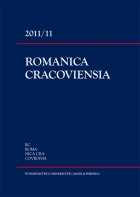Dobletes “románicos” en español (1611–1739). Presentación del fenómeno
Romance Doublets in Spanish (1611–1739). Presentation of the phenomenon
Author(s): Ewa StalaSubject(s): Language and Literature Studies
Published by: Wydawnictwo Uniwersytetu Jagiellońskiego
Summary/Abstract: The borrowings from a classical language, in this case Latin, is a common phemomenon in the Romance languages. In this type of borrowings, they can be direct (L1 → L2) or rather can be borrowed indirectly, by another language, in case of Spanish, it is mainly a Romance language (L1 → L2 → L3). Sometimes, as effect of appearance of such a borrowing in the target language, an etymological doublet can be created: a pair (or a group) of lexems with the same Latin root, one of which is a Romance borrowing, while the other is a direct borrowing from Latin or an inheritated Latin word. In this article we present only the process itself and a few equivalents in other romance languages. For a thorough analysis of the wider issues, please refer to the sketch (Stala 2012) reproduced in the bibliography.
Journal: Romanica Cracoviensia
- Issue Year: 2011
- Issue No: 11
- Page Range: 409-414
- Page Count: 6
- Language: Spanish

